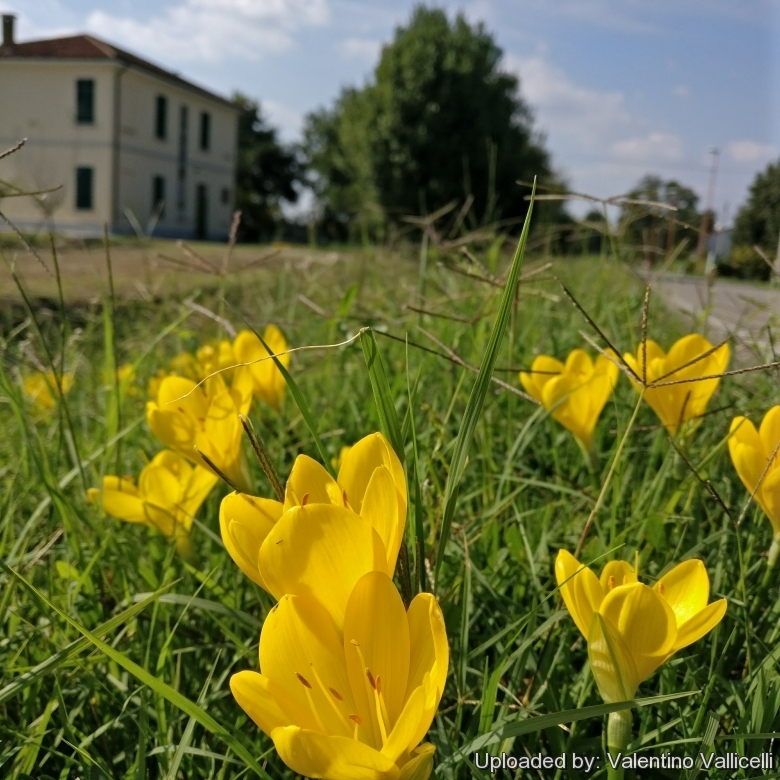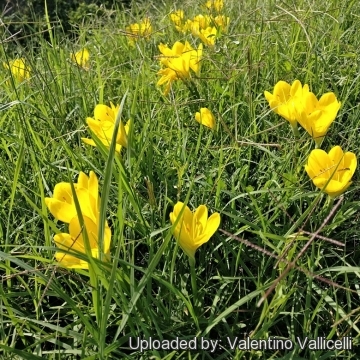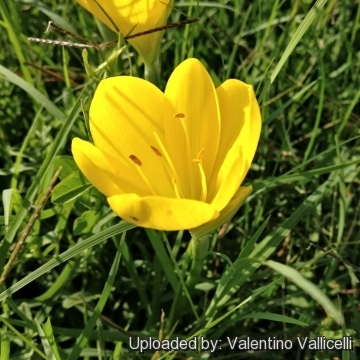Accepted Scientific Name: Sternbergia lutea (L.) Ker Gawl. ex Spreng.
Syst. Veg. (ed. 16) [Sprengel] 7(2): 795. 1830 [Oct-Dec 1830] Spreng.

Oporanthus luteus (Sternbergia lutea) Photo by: Valentino Vallicelli
Sternbergia lutea is one of the oldest of cultivated flowers. Some historians believe that this plant is the “Lily of the Field” referred to in the Bible.
Origin and Habitat: Sternbergia luteaSN|33170]]SN|33170]] from the Balearic Islands in the Western Mediterranean Spain, through Italy, Sicily, ex Yugoslavia, Albania, Greece, ex URSS, Iran, Turkey, Israel and Iraq, through to Tajikistan in Central Asia. It is also present in Nort Africa (Tunisia, Algeria and Morocco).
Altitude range: 200-1000 metres above sea level.
Habitat: Grasslands, screes and open wood margins, on rocky (generally calcareous) substrates. This species is widespread as native species and often also as cultivated ornamental.
Synonyms:
See all synonyms of Sternbergia lutea
back
Accepted name in llifle Database:Sternbergia lutea (L.) Ker Gawl. ex Spreng.Syst. Veg. (ed. 16) [Sprengel] 7(2): 795. 1830 [Oct-Dec 1830]Synonymy: 9
back
Common Names include:
ENGLISH: winter daffodil, autumn daffodil, fall daffodil, lily-of-the-field, yellow autumn crocus, fall crocus
FRENCH (Français): Crocus jaune d'automne, vendangeuse
GERMAN (Deutsch): Herbst-Goldbecher
ITALIAN (Italiano): zafferanastro giallo
PERSIAN (فارسی): جام زرین پائیزه
RUSSIAN (Русский): Штернбергия жёлтая
Description: Autumn Daffodils (Sternbergia luteaSN|33170]]SN|33170]]) are charming Autumn-flowering bulb that are often mistaken for crocuses, but they have six stamens, which preclude all possibility of their being members of the iris family (Iridaceae), to which crocuses belong. Flowers of the iris family have only three stamens. Stembergias belong to the family Amaryllidaceae, subfamily Amaryllidoideae. Unlike crocuses, which have solid bulb-like organs called corms, stembergias have true bulbs formed, like onions, with con-centric layers. In autumn S. lutea sends up dark green, slender, strap-shaped leaves. From the centre of these, one or more rich golden chalices, 4-5 cm long are produced. These blooms are of firm substance and remain decorative for a long time.
Bulb: Medium-sized sub-sphaerical.
Leaves: Up to 9, linear or narrowly-strap-shaped, keeled, rounded at apex, with papillose margins, glossy green, (8-)15-20(-30) cm long and up to 1-2 cm wide. Leaves first appear in the autumn (September to November in its native habitats), stay all winter, and die in late spring.
Flowers: 1-3 on a 5-20 cm long and solid scape or stalk. Flowers erect, funnel shaped, usually solitary, deep yellow emerging from a green spathe and appearing soon after the leaves. The blooms have perianth tubes that broaden above into six equal, lanceolate or obovate tepals rounded at apex or shortly mucronate, around 3–7 cm long and 1-2 cm wide. There are six yellow stamens with filaments conniving and inserted at equal height in the tube. The style is slender and tipped with a single tri-lobed stigma. All parts: the six grey-striated tepals, the six yellow stamens with its anthers, and the style with its stigma are yellow.
Fruits: Fleshy capsules 1.5-2.5 × 1-1.5 cm.
Chromosome number: 2n = 22 (33). Typically, cultivated plants are triploid and natural populations are diploid.
Bibliography: Major references and further lectures
1) Thomas H. Everett “The New York Botanical Garden Illustrated Encyclopedia of Horticulture”, Volume 10 Taylor & Francis, 1982
2) Chris Wiesinger, William C. Welch “The Bulb Hunter” Texas A&M University Press, 27 September 2013
3) The genus
4) Peruzzi Lorenzo, Claudia Di Benedetto, Gabriella Aquaro and Katia Francesca Caparelli “Sternbergia Waldst. & Kit. (Amaryllidaceae) in Italy. Contribution to the cytotaxonomical and morpho-anatomical knowledge” CARYOLOGIA Vol. 61, no. 1: 107-113, 2008
5) Evans, Erv & De Hertough, A.A., “Sternbergia lutea; Winter daffodil, Fall daffodil, Yellow Autumn crocus”, NC State University, <http://www.webcitation.org/61pzU2TuA>retrieved 2 Oct. 2016.
6) Wikipedia contributors. "Sternbergia lutea." Wikipedia, The Free Encyclopedia. Wikipedia, The Free Encyclopedia, 12 Sep. 2016. Web. 2 Oct. 2016.
7) John Lindley “Edwards's Botanical Register: or Ornamental Flower-Garden and Shrubbery: Consisting of Coloured Figures of Plants and Shrubs, Cultivated in British Gardens” 1830
8) Morales R., Castillo J., 2005. El género “Sternbergia (Amaryllidaceae) en la Península Ibérica.c An. Jard. Bot. Madrid 61 (2): 119-128.
9) “Atti Soc. tosc. Sci. nat., Mem., Serie B, 116 (2009)
10) pagg. 67-71, figg. 3
11) F. Frignani , F. Geri , G. Gestri , L. Peruzzi “Distribution of the genus Sternbergia Waldst & Kit. (Amaryllidaceae) in Tuscany (Central Italy)Major references and further lectures
1) Thomas H. Everett “The New York Botanical Garden Illustrated Encyclopedia of Horticulture”, Volume 10 Taylor & Francis, 1982
2) Chris Wiesinger, William C. Welch “The Bulb Hunter” Texas A&M University Press, 27 September 2013
3) The genus
4) Peruzzi Lorenzo, Claudia Di Benedetto, Gabriella Aquaro and Katia Francesca Caparelli “Sternbergia Waldst. & Kit. (Amaryllidaceae) in Italy. Contribution to the cytotaxonomical and morpho-anatomical knowledge” CARYOLOGIA Vol. 61, no. 1: 107-113, 2008
5) Evans, Erv & De Hertough, A.A., “Sternbergia lutea; Winter daffodil, Fall daffodil, Yellow Autumn crocus”, NC State University, <http://www.webcitation.org/61pzU2TuA>retrieved 2 Oct. 2016.
6) Wikipedia contributors. "Sternbergia lutea." Wikipedia, The Free Encyclopedia. Wikipedia, The Free Encyclopedia, 12 Sep. 2016. Web. 2 Oct. 2016.
7) John Lindley “Edwards's Botanical Register: or Ornamental Flower-Garden and Shrubbery: Consisting of Coloured Figures of Plants and Shrubs, Cultivated in British Gardens” 1830
8) Morales R., Castillo J., 2005. El género “Sternbergia (Amaryllidaceae) en la Península Ibérica.” An. Jard. Bot. Madrid 61 (2): 119-128.
9) “Atti Soc. tosc. Sci. nat., Mem., Serie B, 116 (2009)
10) pagg. 67-71, figg. 3
11) F. Frignani , F. Geri , G. Gestri , L. Peruzzi “Distribution of the genus Sternbergia Waldst & Kit. (Amaryllidaceae) in Tuscany (Central Italy) Atti Soc. tosc. Sci. nat., Mem., Serie B, 116 (2009) pagg. 67-71, figg. 3 Atti Soc. tosc. Sci. nat., Mem., Serie B, 116 (2009) pagg. 67-71, figg. 3
 Oporanthus luteus (Sternbergia lutea) Photo by: Valentino Vallicelli
Oporanthus luteus (Sternbergia lutea) Photo by: Valentino Vallicelli Oporanthus luteus (Sternbergia lutea) Photo by: Valentino Vallicelli
Oporanthus luteus (Sternbergia lutea) Photo by: Valentino VallicelliCultivation and Propagation: Sternbergia luteaSN|33170]]SN|33170]] is a perennial, summer deciduous plant and used as ornamentalt. It can can grow in mediterranean or temperate climate.
Soil. This species grows best in and deep, nutritious soil that tends to be dryish rather than wet. Alkaline soils are recommended.
Light requirements: Sternbergias need sun or light, part-day shade.
Hardiness: Sternbergia luteaSN|33170]]SN|33170]] is hardy to USDA hardiness zones 7–9 (−18 to −1 °C) depending on the degree of protection given. A warm dry period in summer is required for good flowering
Warning: The bulbs of S. lute are poisonous if eaten.
Propagation: By offsets, bulb cuttings, and seed. Bulbs are usually planted while dormant (i.e. in late summer or early autumn), but can be lifted and divided before the leaves die down in late spring.Newly planted bulbs commonly take two or three years to become established. The bulbs are planted at depths of 10-15 cm, after making sure that beneath them is a deep layer of earth of a quality encouraging to roots.











